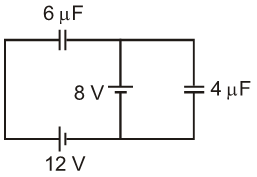If E be the electric field inside a parallel plate capacitor due to Q and -Q charges on the two plates, then electrostatic force on plate having charge -Q due to the plate having charge +Q will be
(1) -QE
(2)
(3) QE
(4)
यदि E, दो प्लेटों पर Q और -Q आवेशों के कारण समांतर प्लेट संधारित्र के अंदर विद्युत क्षेत्र है, तब आवेश -Q की प्लेट पर आवेश +Q की प्लेट के कारण स्थिरवैद्युत बल होगा:
(1)
(2)
(3)
(4)
In the circuit shown in figure, energy stored in 6 capacitor will be

1.
2.
3.
4.
चित्र में दिखाए गए परिपथ में, 6 संधारित्र पर संचित ऊर्जा होगी:

1.
2.
3.
4.
The electric field inside a spherical shell of uniform surface charge density is -
(1) Zero
(2) Constant, less than zero
(3) Directly proportional to the distance from the centre
(4) None of the above
एकसमान आवेश घनत्व के एक गोलीय कोष के अंदर विद्युत क्षेत्र कितना है -
(1) शून्य
(2) नियत, शून्य से कम
(3) केंद्र से दूरी के समानुपाती
(4) उपरोक्त में से कोई नहीं
A hollow metallic sphere of radius R is given a charge Q. Then the potential at the centre is -
(1) Zero
(2)
(3)
(4)
R त्रिज्या के एक खोखले धातु गोलक को Q आवेश दिया जाता है। तब केंद्र पर विभव है -
(1) शून्य
(2)
(3)
(4)
Inside a hollow charged spherical conductor, the potential -
(1) Is constant
(2) Varies directly as the distance from the centre
(3) Varies inversely as the distance from the centre
(4) Varies inversely as the square of the distance from the centre
एक खोखले आवेशित गोलीय चालक के अंदर, विभव -
(1) नियत है।
(2) केंद्र से दूरी के रूप में सीधे परिवर्तित होता है।
(3) केंद्र से दूरी के रूप में व्युत्क्रमानुसार परिवर्तित होता है।
(4) केंद्र से दूरी के वर्ग के रूप में व्युत्क्रमानुसार परिवर्तित होता है।
Assertion : Electric potential and electric potential energy are different quantities.
Reason : For a system of positive test charge and point charge electric potential energy = electric potential.
अभिकथन: विद्युत विभव और विद्युत स्थितिज ऊर्जा अलग-अलग राशियाँ हैं।
कारण: धनात्मक परीक्षण आवेश और बिंदु आवेश के निकाय के लिए, विद्युत स्थितिज ऊर्जा = विद्युत विभव।
- If both the assertion and the reason are true and the reason is a correct explanation of the assertion
- If both the assertion and reason are true but the reason is not a correct explanation of the assertion
- If the assertion is true but the reason is false
- If both the assertion and reason are false
Assertion : Electric potential is a property of an electric field, regardless of whether a charged
object has been placed in that field.
Reason : Potential depends on test charge.
अभिकथन: विद्युत विभव, विद्युत क्षेत्र का एक गुण है, चाहे आवेशित पिंड को उस क्षेत्र में रखा गया हो।
कारण: विभवांतर, परिक्षण आवेश पर निर्भर होता है।
- If both the assertion and the reason are true and the reason is a correct explanation of the assertion
- If both the assertion and reason are true but the reason is not a correct explanation of the assertion
- If the assertion is true but the reason is false
- If both the assertion and reason are false
Capacitors \(C_1= 10 \mu F\) and \(C_2= 30 \mu F\) are connected in series across a source of emf 20KV. The potential difference across \(C_1\) will be
| 1. | 5 KV | 2. | 15 KV |
| 3. | 10 KV | 4. | 20 KV |
\(C_1= 10 \mu F\) और \(C_2= 30 \mu F\) के संधारित्रों को 20KV के विद्युत वाहक बल के स्रोत के बीच श्रेणीक्रम में जोड़ा जाता है। \(C_1\) में विभवांतर होगा -
| 1. | 5 KV | 2. | 15 KV |
| 3. | 10 KV |
4. | 20 KV |
A proton and an -particle are at a distance r from each other. After letting them free if they move to infinity, the kinetic energy of the proton will be -
1.
2.
3.
4.
एक प्रोटॉन और एक -कण एक दूसरे से r दूरी पर हैं। इन्हें मुक्त करने के बाद, यदि ये अनंत की ओर गति करते हैं, तो प्रोटॉन की गतिज ऊर्जा होगी -
1.
2.
3.
4.
A bullet of mass 2 gm is having a charge of 2 μC. Through what potential difference must it be accelerated, starting from rest, to acquire a speed of 10 m/s ?
| 1. | 5 kV | 2. | 50 kV |
| 3. | 5 V | 4. | 50 V |
2 gm द्रव्यमान की एक गोली 2 μC का आवेश वहन करती है। विरामावस्था से, 10 मीटर/सेकंड की चाल प्राप्त करने के लिए, किस विभवांतर के माध्यम से इसे त्वरित किया जाना चाहिए?
| 1. | 5 kV | 2. | 50 kV |
| 3. | 5 V |
4. | 50 V |






